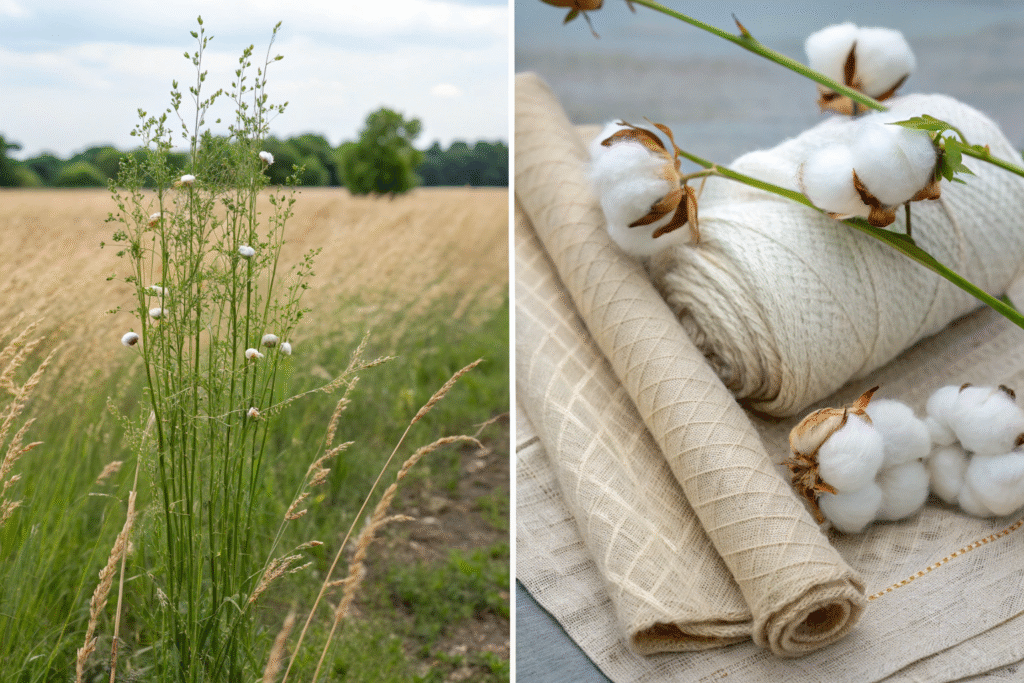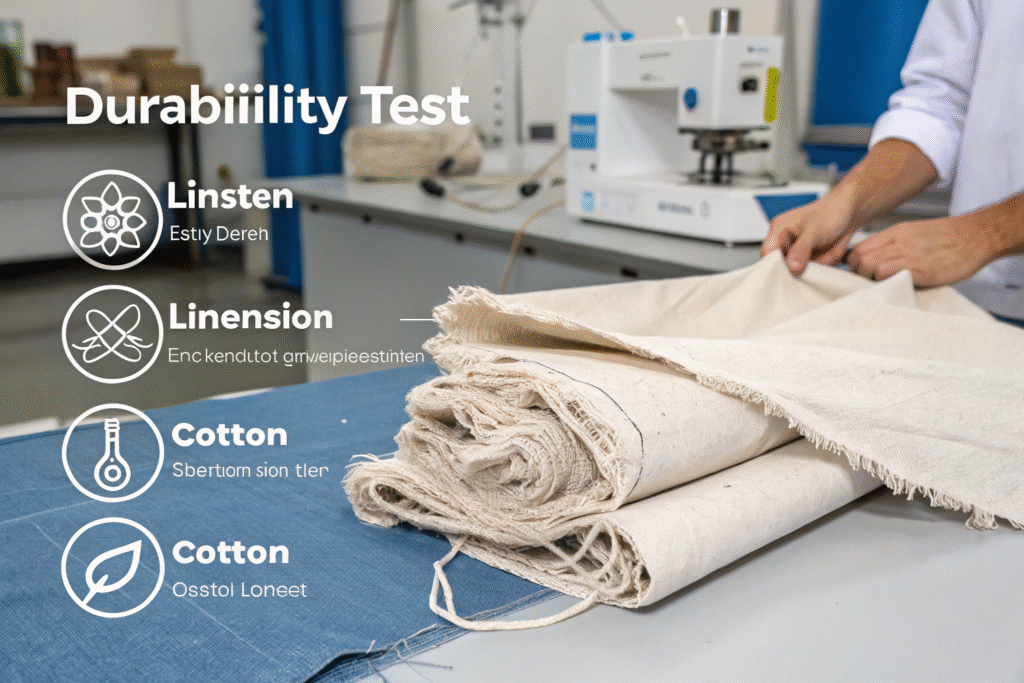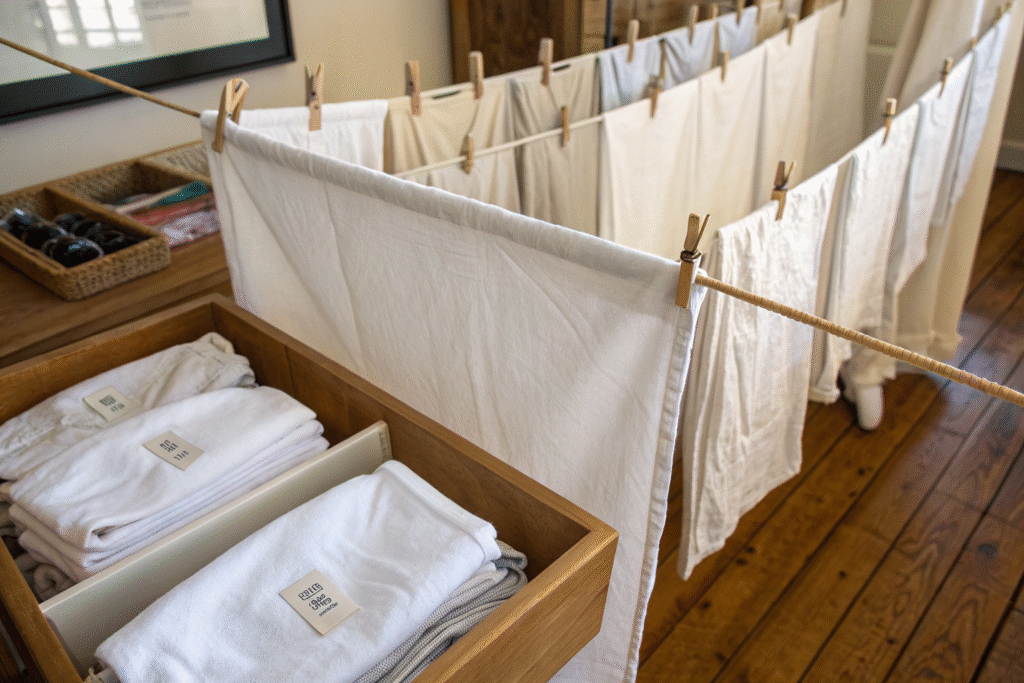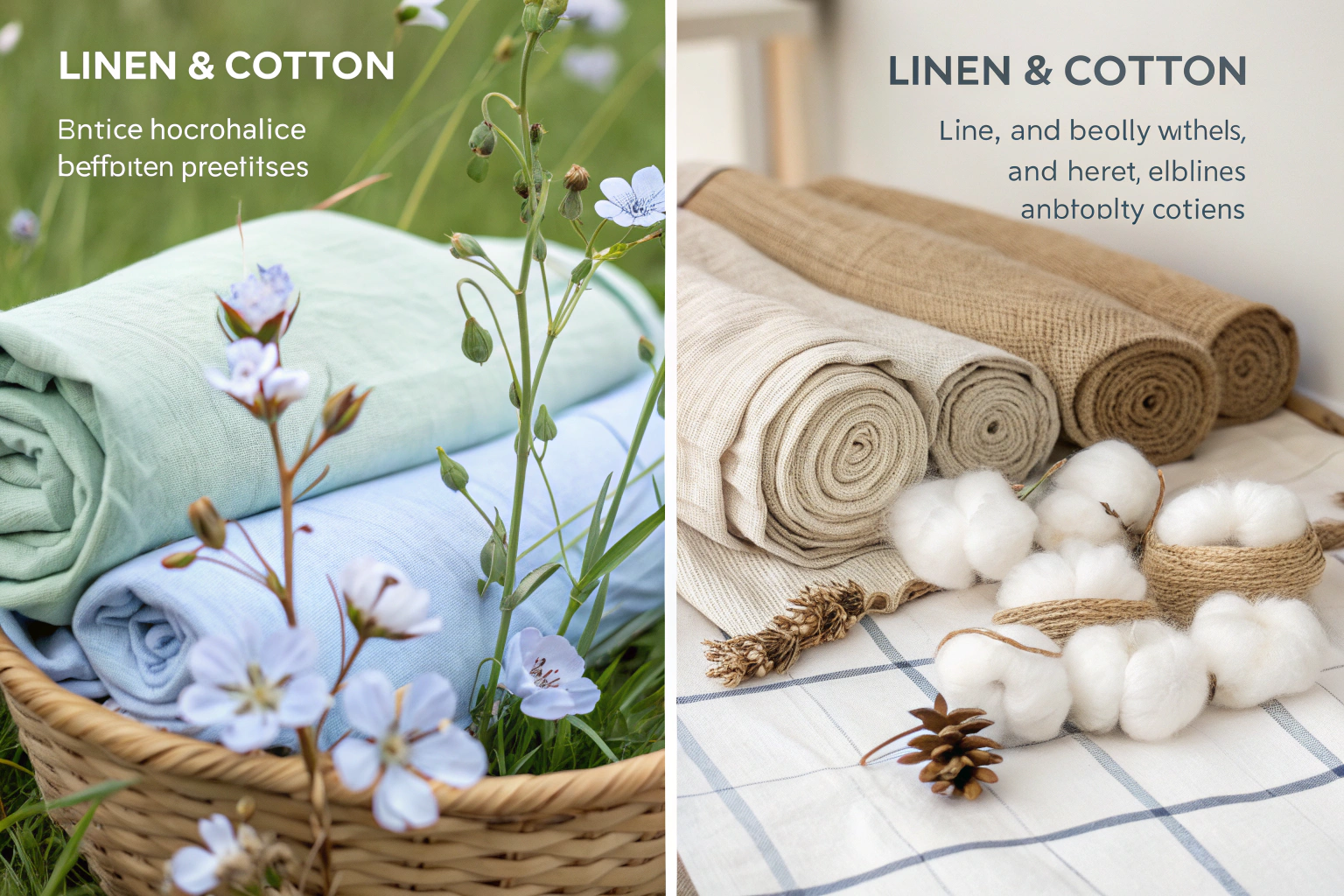Both linen and cotton are among the world’s most widely used natural fabrics, but they differ in origins, performance, and applications. When fashion brands, home textile buyers, or fabric traders source materials, the choice between the two often determines how the final product feels, performs, and even sells in the marketplace.
The main difference is that linen is derived from the stalk of the flax plant, while cotton is harvested from the fluffy bolls of the cotton plant. Linen is stronger, more breathable, and excels in hot climates, but wrinkles easily. Cotton, by contrast, is softer, easier to handle, and globally abundant, though it tends to wear out faster than linen.
From my 20 years in fabric production and exports, I have seen buyers debate whether to invest in linen’s premium performance or cotton’s versatile affordability. To guide your choice, let’s break down the fiber origins, durability, comfort, care, and cost differences in detail.
Linen vs Cotton: Fiber Origins and Texture
The origins of linen and cotton are fundamentally different, and this distinction shapes their texture, strength, and overall feel.
Linen fibers are extracted from the stalk of the flax plant, which has been cultivated for over 6,000 years across regions like Egypt, Belgium, and northern France. The extraction process—retting, breaking, and scutching—produces long, lustrous fibers that weave into crisp, cool fabrics. Because the flax fibers are stiff and irregular, linen cloth often displays natural “slubs,” giving it a textured, artisanal look.
Cotton fibers grow from the seed boll of the cotton plant, a crop that accounts for about 25% of all global fiber use today. Each boll contains thousands of soft fibers that can be spun into yarns of varying fineness. This explains why cotton can produce ultra-soft baby clothes, lightweight shirting fabrics, or heavy-duty denim. Unlike linen, cotton fibers are shorter and finer, creating a naturally smooth, even texture.

Why does linen feel rougher than cotton?
Linen fibers measure 25–150 mm in length and are stiffer, so fresh linen garments can feel crisp or even coarse. Yet, with each wash, the fibers soften without breaking down, so linen sheets or shirts become more comfortable with age. Cotton, with fibers averaging 10–50 mm in length, is smooth from the start and immediately skin-friendly. CottonWorks offers detailed studies on cotton’s fiber length and softness. Masters of Linen similarly highlights how flax cultivation contributes to linen’s distinct hand feel.
Is one fiber more sustainable than the other?
Flax requires far less water and pesticides to grow than cotton, making linen inherently eco-friendly. For example, a linen shirt typically uses only one-quarter of the water needed for a cotton shirt. Cotton, however, has massive global support networks, with initiatives like the Better Cotton Initiative driving more responsible farming. Flax thrives in Europe’s cooler climates without irrigation, while cotton farming dominates in the U.S., India, and China, often relying on large-scale water use.
Strength and Durability Compared
Durability often decides whether fabric buyers choose linen for premium products or cotton for everyday mass-market goods.
Linen fibers are 20–30% stronger than cotton fibers, making them one of the strongest natural fibers in textiles. This strength means a high-quality linen tablecloth, if properly cared for, can last 20–30 years, while an equivalent cotton cloth might thin out in 8–10 years of frequent washing. Cotton remains durable, especially in heavier constructions like denim, but in lightweight applications such as shirts, it tends to degrade faster.

Does linen really last longer than cotton?
Yes. Linen’s long-staple fibers have high tensile strength, allowing them to withstand stress without breaking. Archaeological discoveries of Egyptian mummies wrapped in linen more than 3,000 years ago testify to its enduring strength. Cotton sheets, though cozy, typically last 5–10 years before showing wear. Studies published in ScienceDirect confirm that linen’s crystalline cellulose structure gives it superior resilience.
Why do brands still prefer cotton despite its lower strength?
Cotton is valued for its versatility. It can be spun into fine yarns for silky shirting, looped into absorbent terry towels, or woven into heavy denim. It also blends easily with synthetics like polyester to boost durability. This adaptability explains why cotton remains the world’s leading apparel fiber, representing more than 50% of total clothing production according to Textile World.
Comfort, Breathability, and Climate Performance
Comfort is often the deciding factor for clothing buyers, especially in summer wear.
Linen is highly breathable, moisture-wicking, and naturally cool to the touch, making it perfect for hot and humid climates. Cotton is breathable too, but it absorbs and holds more moisture, which can make it feel heavy in extreme humidity.

Why is linen better for summer wear?
Linen fibers are hollow, allowing air to flow freely. This reduces body heat and promotes evaporation of sweat. For instance, linen shirts in Southeast Asia or Mediterranean countries are popular because they keep the body 2–3°C cooler than cotton in direct sun. The European Flax Association refers to linen as the “air conditioner” of textiles due to its cooling effect.
Is cotton better for cooler or mixed climates?
Yes. Cotton’s ability to absorb up to 27 times its weight in water makes it cozy in transitional seasons. Cotton flannels, jerseys, and fleece are staples for autumn and winter wear. Cotton’s softness also makes it suitable for baby clothing and underwear. According to Cotton Inc., cotton’s flexibility across weaves and fabric weights is unmatched, allowing it to serve as a year-round material.
Care, Wrinkles, and Cost Considerations
For many buyers, the practicality of care and the cost of fabric determine the final choice.
Linen wrinkles easily due to its stiff, inelastic fibers. Cotton, on the other hand, is more wrinkle-resistant and easier to maintain, especially when treated with modern finishes. Linen typically costs more than cotton because flax cultivation is labor-intensive and geographically limited, while cotton is mass-produced worldwide.

Why does linen wrinkle so much?
When linen fibers bend, they lack elasticity to return to their original form, which causes permanent creases. This gives linen clothing its relaxed, casual style. Today, fabric technologists blend linen with cotton or polyester to reduce wrinkles while retaining breathability. Good On You reviews how such blends help balance fashion and function.
Is the higher price of linen worth it?
Yes, particularly for high-end buyers. A set of luxury linen sheets might cost twice as much as cotton sheets but can last three times longer. Linen’s prestige also adds value to luxury home textiles and designer fashion collections. FashionUnited notes that linen has carved a niche as a premium eco-fabric, while cotton dominates global mass production due to affordability and versatility.
Conclusion
Linen and cotton are both essential to the global textile industry, but they serve different needs. Linen stands out for durability, breathability, and sustainability, making it the perfect choice for luxury summer clothing and premium home textiles. Cotton, meanwhile, remains unbeatable for softness, adaptability, and affordability, dominating everyday clothing and mass-market production.
For fashion brands, fabric traders, and home textile buyers, the decision depends on whether your priority is luxury and long-term performance (linen) or cost-effectiveness and versatility (cotton). Both have their place in modern wardrobes and homes.
At Shanghai Fumao, we specialize in both fabrics, offering end-to-end services from weaving and dyeing to embroidery and coating. If you are ready to launch or expand your clothing line, we can supply premium fabrics tailored to your brand’s needs. Contact our Business Director Elaine at elaine@fumaoclothing.com to co-create high-quality fabrics that match your market vision.










